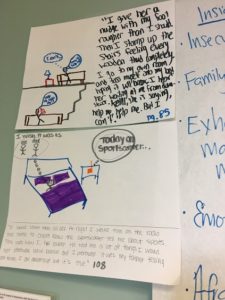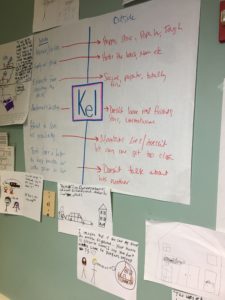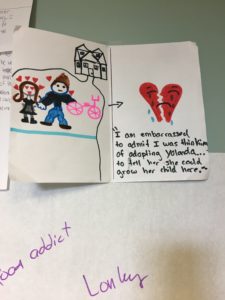October 4, 2017
by Kaia Cunningham
As a lifelong fan of literature, my favorite day of any week in the classroom is when we have class discussions on our current novel. When I first started teaching, discussion was what I was most looking forward to, so I found it discouraging to realize that how I’d imagined this to go was not the reality. The discussions were powered by my voice and my perspective, and they were reliant on only a few student’s contributions. It was lackluster at best. When a supervisor observed a discussion in my class, she suggested that I revamp my approach using the Landmark Six Teaching Principles™.
Landmark created The Six Teaching Principles™ to help teachers support all learners in their classrooms. Although these guidelines are designed to empower students with language-based learning disabilities, they are just good teaching practices to incorporate into any type of classroom for any type of student. When I reflect back on my favorite or most successful lessons, I realize that they were successful, and ultimately my favorite, because they incorporated these principles. And when something I teach isn’t successful and I consider why, most of the time it’s because it was missing a key element of one of these principles. Here is a link that explains each of these principles:
After meeting with my supervisor about this observation, I assessed how I was approaching the discussion process in my class. I realized that the first step was to let the students drive the discussion instead of relying on me to move and clarify the conversation. Since practice makes perfect, I knew I needed to make a discussion routine so students would be comfortable with the process and understand my expectations. I also needed trust that they could guide the discussion on their own and not jump in when the silence got awkward. This would not only ensure automatization of the elements of a discussion through practice and review, but it would also include the students in the learning process.
Not only did I need to create the opportunity and time to allow them to have the discussion, I also needed to structure and micro-unit the activity. Instead having them make open-ended statements with text evidence using a theme to guide their thinking (which always resulted in students saying the same things over and over again and not really responding to each other), I created varied open-ended statements from pre-established themes and had students create questions from those statements. For example, this year in 9th grade literature when we discussed Heft by Liz Moore, I broke up the class into groups, assigned each group a single, specific statement, and had them brainstorm related questions. Here’s a sampling of the statements:
These statements varied the focus of questions for the discussion. It also narrowed the lense for each group. They only had to think of questions and locate information for that specific statement. Students used the attached template to brainstorm their questions, record answers to their questions, and record text evidence that would support their answer. Front loading this type of information can provide an opportunity for success, as it helps all students feel like they have something to contribute without overtaxing their working memory. Additionally, having students brainstorm questions to the discussion includes them in the learning process. Once I established this routine, we approached discussions this way over and over again until it became automatic and routine.
When I created this template, I thought, “Okay, they have structure to ask questions on a range of topics, but what about the types questions they ask?” I wanted them to pose questions that required more than a one-word or yes/no response. I could not assume that the students would have the skills to do this, so I needed to make sure I helped them front load information to be able to contribute to a discussion and ensure that they knew how to ask good questions. Before we had the discussion, we practiced assessing and writing good discussion questions. We engaged in the attached activity, which structured the task of creating questions and created a model for students to follow as they brainstormed their own questions. We also discussed and used Bloom’s Taxonomy to examine how different types of questions are built to guide them towards more abstract thinking.
In reviewing how I had planned this activity, I realized I had forgotten a very important piece: I needed to teach them specifically how to participate in a discussion! They needed to understand and be able to visualize what a good discussion looked and sounded like. Together we brainstormed the attributes of a good discussion. We visualized what each member was going to do and how they were going to act. Then, we created a rubric together for self-reflection. At the end of each discussion, I saved time for students to fill out the rubric, and I did the same for each of them so that students could continue to refine their participation. This provided a clear model for discussion and included the students in how they will be evaluated.
Finally, I knew that I wanted to incorporate some sort of visual representation as a way to finalize and support a multisensory approach to discussion. There is some current research on how drawing or doodling can reinforce concepts, particularly for students with dyslexia. At the end of the discussion, students selected a quote and drew an image or a diagram that would represent how that quote represented the initial character statement. Below is a picture of some sample drawings. Drawing their ideas and contributions allowed the students to refine the information through multiple modalities: they read about it, spoke about it, created an image about it, and eventually they will write something about it.



On the surface class discussion seems simple: think of questions and have students respond to them. However, upon close examination and reflection, I saw that to truly teach students how to have a discussion, each part needs to be broken down into a set of skills and then built back up to a cohesive whole. Using the Six Landmark Teaching Principles™ as a guide helped me create a set of routines and strategies that explicitly taught students the skills to engage in a productive, student-led discussion.

Kaia has been at Landmark since 2006. In addition to her work for Outreach, she has been a language arts teacher at Landmark High School. Previously, her roles and responsibilities included assistant director of the preparatory program, academic advisor, and full-time teacher and tutor. Kaia graduated from The College of Santa Fe with her bachelor’s in English, and she earned her master’s degree in special education from Simmons College.


